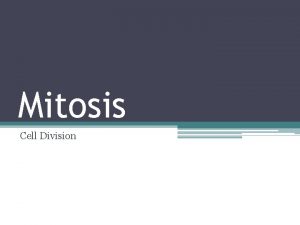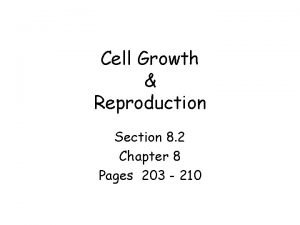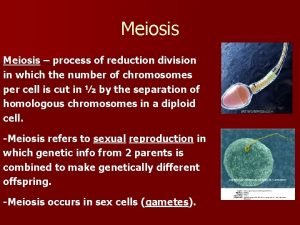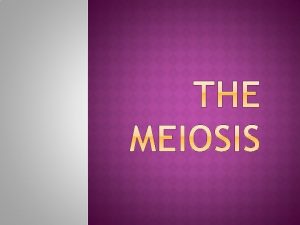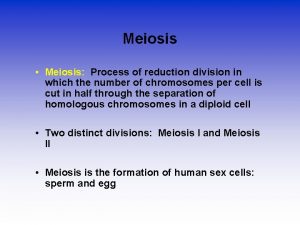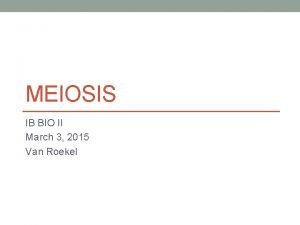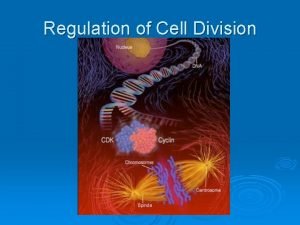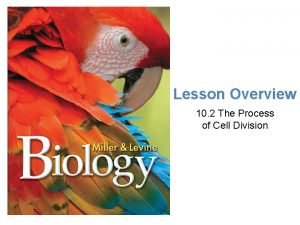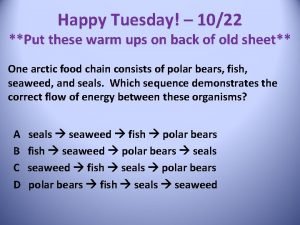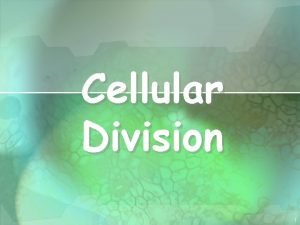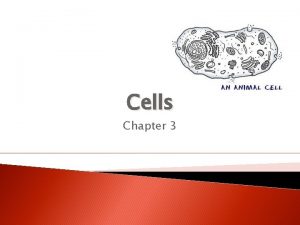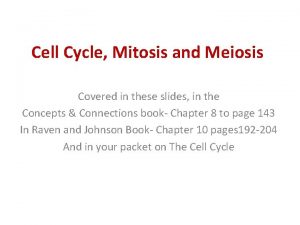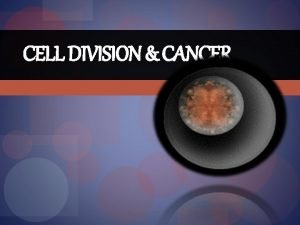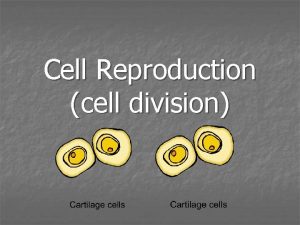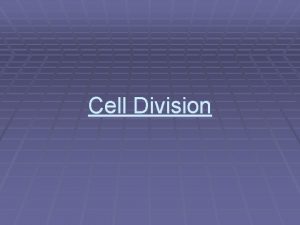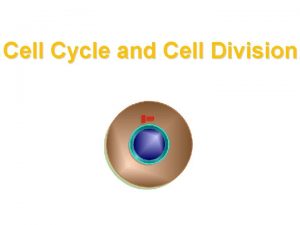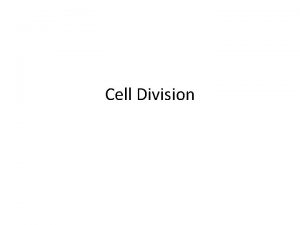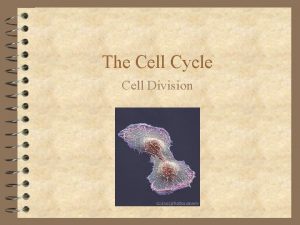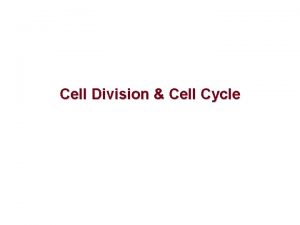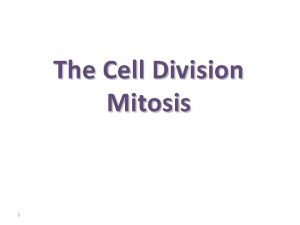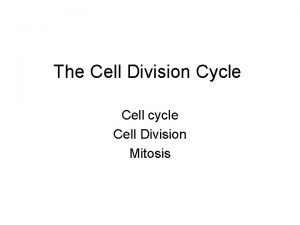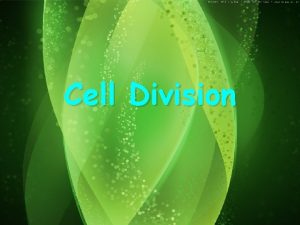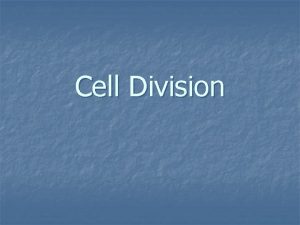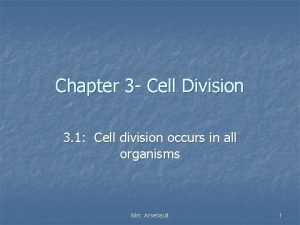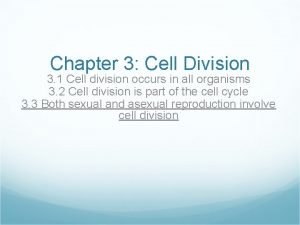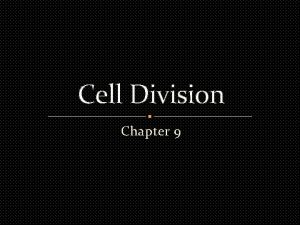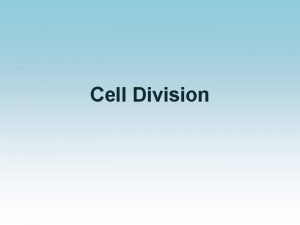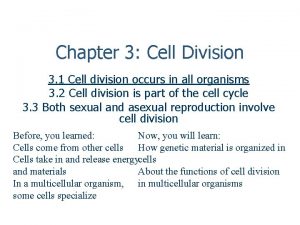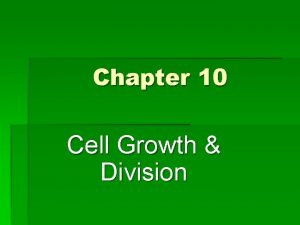CHAPTER 10 Cell Division Why Cell Division We


























- Slides: 26

CHAPTER 10: Cell Division

Why Cell Division? • (We will use the following analogy to understand cell division. ) ANALOGY • A cell is like a town. • The DNA in the nucleus is like the books in a library. • The nucleus doesn’t grow and the DNA doesn’t increase in a cell.

Town Library Analogy • SITUTION: You have a research project. Your town has grown from 1000 to 10, 000 people, but the library is unchanged. • QUESTION: What is going to happen when you go to check out books for your project?

Town Library Analogy • ANSWER: Books won’t be available. The staff may be having a hard time restocking books, even if they have been returned.

Town Library Analogy • SOLUTION: Build another library in another section of town, stock it with additional copies of books.

CELL • The cell has the same 2 problems. • DNA Overload: The DNA gets to a point where it can’t do more things at the same time. • Exchange of Materials: After a certain size, the cell can’t efficiently transport nutrients (in) and wastes (out)

CELL • SOLUTION: The cell will make an exact copy of itself and divide. • 2 small cells with identical information and able to transport materials easily.

DNA Replication • DNA stores genetic information • It gets replicated (copied) before the cell divides • Therefore, each generation of cells is identical

CELL CYCLE: The process a cell repeats every time it divides

INTERPHASE: When the Cell is NOT Dividing • G 1: & G 2 phases: growth • S Phase: “synthesis”when the DNA is replicated

2 Important Parts of Cell Division 1. Mitosisdivision of the nucleus 2. Cytokinesis. Division of the cytoplasm (cell splits)

MITOSIS ↓ CYTOKINESIS ↓

STAGE 1 OF MITOSIS: PROPHASE • DNA is Packaged into Chromosomes • Centrioles move to opposite sides of cell as spindle begins to form • Nuclear envelope breaks down duplicated chromosome chromatin prophase

STAGE 2 OF MITOSIS: METAPHASE • Chromosomes line up in center of cell • Each chromatid is attached to a spindle fiber at its centromere metaphase

STAGE 3 OF MITOSIS: ANAPHASE • Sister chromatids separate & move to opposite ends of cell.

STAGE 4 OF MITOSIS: TELOPHASE • Chromosomes are at opposite ends of cell & become chromatin again • New nuclear envelopes form

Mitosis in Action Blue shows DNA, green shows spindle fibers.

AFTER MITOSIS: CYTOKINESIS cell divides into 2 cells ANIMAL CELL: Pinches into 2 cells PLANT CELL: cell walls forms between 2 new cells

REGULATION OF CELL CYCLE Cyclins are chemicals that control cell division 1. Internal Regulators-cyclins inside the cell that control its division 2. External regulators- cyclins outside the cell that control its division

Example of Regulators • Internal: When you get a cut, your cells send out cyclins so that new cells will be made (cell division) • External: When the cells touch (cut is healed), cyclins tell cells to stop dividing.

Cancer Is One Outcome of A Runaway Cell Cycle Licentious division - prostate cancer cells during division.

CANCER: Regulators out of Control • Cancer: cells dividing out of control • Often an error in the p 53 gene that regulates cell division

Why Cancer is a Problem –Cancer cells aren’t poisonous –They rob your body of nutrients. –They can develop their own network of blood vessels. • Rob your body faster • Pathway for cancer to spread through your body. (“metastasis”)

Cancer Treatment Chemotherapy & Radiation are used to kill cancer cells. 1. Benefits: cancer cells are killed 2. Drawbacks: many healthy cells can be killed too.

Chemotherapy • Use of medications

Radiation • Use of exposure to radioactive elements, which destroy cells.
 Why why why why
Why why why why Why is cell division important
Why is cell division important Cell cycle and cell division
Cell cycle and cell division Cell cycle and cell division
Cell cycle and cell division Cell cycle and cell division
Cell cycle and cell division Don't ask why why why
Don't ask why why why Chapter 8 cell growth and division section 8-2 answer key
Chapter 8 cell growth and division section 8-2 answer key The scientist mathias schleiden studied _______ in ______.
The scientist mathias schleiden studied _______ in ______. Short division vs long division
Short division vs long division Synthetic divisin
Synthetic divisin 2065 divided by 5
2065 divided by 5 Synthetic dividion
Synthetic dividion Why is meiosis referred to as reductional division
Why is meiosis referred to as reductional division Process of reduction division
Process of reduction division Why is meiosis referred to as reductional division
Why is meiosis referred to as reductional division Why is meiosis referred to as reductional division
Why is meiosis referred to as reductional division Why is meiosis referred to as reductional division
Why is meiosis referred to as reductional division Pmat
Pmat Frequency of cell division
Frequency of cell division Cell cycle concept map
Cell cycle concept map Cell division
Cell division Ipmatc acronym ideas
Ipmatc acronym ideas Cell division name
Cell division name When cell division does not occur in the usual pattern a(n)
When cell division does not occur in the usual pattern a(n) Asexual reproduction cell division
Asexual reproduction cell division Mitosis and meiosis
Mitosis and meiosis Do sister chromatids separate in meiosis
Do sister chromatids separate in meiosis

